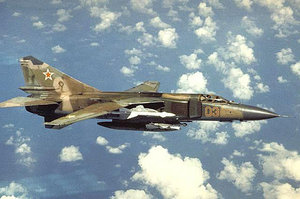Mikoyan-Gurevich MiG-23
|
|
The Mikoyan-Gurevich MiG-23 (NATO reporting name 'Flogger') is a swing-wing fighter aircraft, originally built by the Mikoyan-Gurevich Design Bureau in the Soviet Union. Produced in large numbers, it remains in limited service with various export customers.
Development
The MiG-23's predecessor, the MiG-21, was fast and agile, but extremely limited in its operational capabilities, with primitive radar, short range, and a limited weapons load (restricted in some aircraft to a pair of short-range air-to-air missiles). The MiG-23 was a heavier, more powerful machine designed to remedy these deficiencies, and, it was hoped, rival Western aircraft like the F-4 Phantom.
A major design consideration was take-off and landing performance. The Soviets' existing fast jets required very long runways, which, combined with their limited range, limited their tactical usefulness. The VVS demanded that the new aircraft have a much shorter take-off run. This led Mikoyan to consider two alternatives: lift jets to provide an additional lift component and variable-geometry wings. The latter, which had been developed by TsAGI for both 'clean-sheet' aircraft designs and adaptations of existing designs, proved more promising, and the MiG-23S ('Flogger-A') was accepted for production in 1969. Only 50 of the initial preproduction model were built, production switching to the first mass-production version, the MiG-23M ('Flogger-B') and its associated two-seat trainer version, the MiG-23UB ('Flogger-C'). The MiG-23 entered service in June 1972.
It was subsequently produced in many variants, including several dedicated ground-attack models, the ultimate example of which was the MiG-27.
The MiG-23 was produced in large numbers and widely exported to many nations, including Afghanistan, Algeria, Angola, Bulgaria, Cuba, Czechoslovakia, Egypt, Ethiopia, Hungary, India, Iraq, Libya, North Korea, Poland, Romania, South Yemen, Syria, and Vietnam.
The MiG-23 was gradually phased out of Soviet service in the 1980s in favor of newer types. The last front-line 'Flogger' fighters were retired in 1997.
The MiG-23's combat performance in conflicts with Israeli and U.S. pilots was generally poor. Against the F-14, F-15, and F-16, it was picked from the sky in large numbers without inflicting any losses in return. Pilot skill was a considerable factor, but despite its positive attributes (including impressive acceleration and straight-line speed), the 'Flogger's' poor visibility, limited maneuverability, and outdated avionics rendered it a non-starter against more advanced Western aircraft.
Specifications (MiG-23MLD 'Flogger-K')
- Length: 16.70 meters (56 ft 9.5 in) including probe
- Wingspan: Spread, 13.97 meters (45 ft 10 in)
- Height: 4.82 meters (15 ft 9.75 in)
- Wing area: (spread) 37.35 m² (402.05 ft²); (swept) 34.16 m² (367.71 ft²)
- Empty weight: 9,595 kg (21,153 lb)
- Normal takeoff weight: 15,700 kg (34,612 lb)
- Maximum takeoff weight: 18,030 kg (39,749 lb)
- Powerplant: One Khatchaturov R-35-300 turbojet
- Thrust: 8,550 kgf (83.6 kN, 18,850 lbf) dry and 13,000 kgf (127 kN, 28,700 lbf) afterburning thrust
- Maximum speed: 2,500 km/h (1,553 mph, Mach 2.35) at altitude; 1,350 km/h (838 mph, Mach 1.14) at sea level
- Combat radius: 1,150 km (572 mi) with six AAMs
- Ferry range: 2,820 km (1,752 mi)
- Rate of climb: 14,400 m/min (47,245 ft/min)
- Service ceiling: 18,500 m (60,695 ft)
- Wing loading: 575 kg/m² (118 lb/ft²)
- Thrust-to-weight ratio: 0.83:1
- Armament:
- one Gryazev-Shipunov GSh-23L 23mm cannon with 200 rounds
- two fuselage, two wing glove, and two wing pylons for up to 3,000 kg (6,614 lb) of stores, typically including R-23 (AA-7 Apex) and R-60 (AA-8 Aphid) and, on upgraded aircraft, R-27 (AA-10 Alamo) and R-73 (AA-11 Archer).
Related Content
| Related content | |
|---|---|
| Related Development | |
| Similar Aircraft | |
| Designation Series |
MiG-17 - MiG-19 - MiG-21 - MiG-23 - MiG-25 - MiG-27 - MiG-29 |
| Related Lists | List of military aircraft of the Soviet Union and the CIS - List of fighter aircraft |
|
Lists of Aircraft | Aircraft manufacturers | Aircraft engines | Aircraft engine manufacturers Airports | Airlines | Air forces | Aircraft weapons | Missiles | Timeline of aviation |

